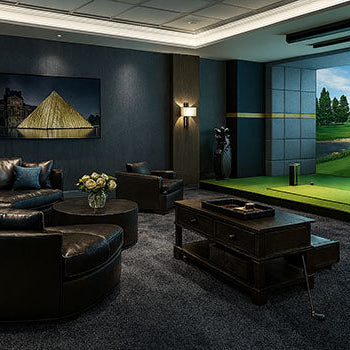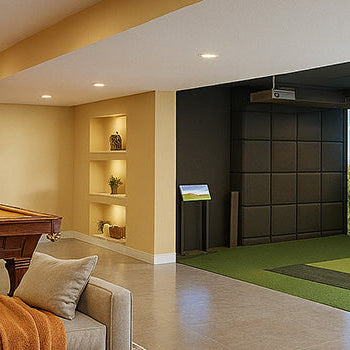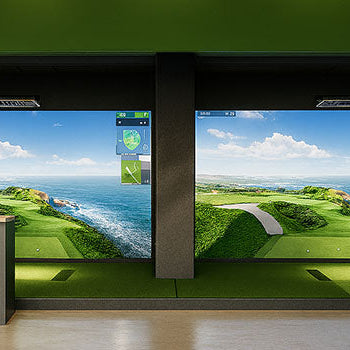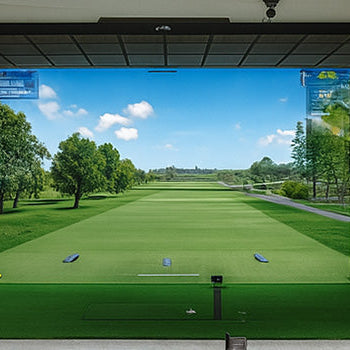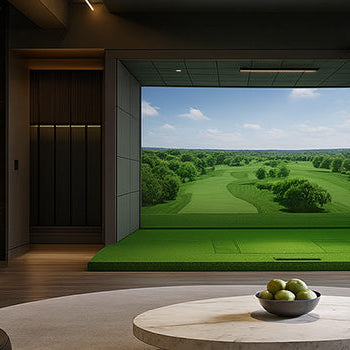Ever dreamed of teeing off beside the toolbox? Yes, you can put a golf simulator in your garage, as long as you’ve got the space and a touch of DIY spirit. With the right setup, your garage can transform into a year-round golf haven. From ceiling clearance to cable chaos, there’s a lot to consider, but we’re breaking it all down step by step. Ready to turn your garage into your own private Pebble Beach? Let’s get started.

Why the Garage is the Most Popular Choice for a Home Simulator
If you're wondering “is a garage big enough for a golf simulator?”. You’re not alone. It turns out, garages are one of the most popular places to build a simulator setup, and for good reason.
The Advantages: Concrete Floors, Ample Space, and Less Disruption
Your garage already has something most rooms don’t, a solid concrete floor built to handle impact. Add the bonus of not having to move furniture or dodge chandeliers, and you’ve got a perfect candidate for a garage golf simulator.
There’s usually more uninterrupted floor space too. That means you can swing freely without worrying about breaking Grandma’s vase.
Turning Unused Space into Your Personal Golf Haven
Let’s be honest, how often are you really using that back corner of the garage? With a little effort, you can turn unused storage space into your very own golf zone.
Picture this: clubs on wall-mounted racks, putting turf under your feet, and The Old Course projected right in front of you. That’s not just practice, it’s therapy.
The First Step: Checking Your Garage Dimensions
Before buying anything, grab a tape measure. This step separates dreamers from doers, and saves you from awkward ceiling dings later.
Measuring Ceiling Height: Clearing the Garage Door Opener
First things first, look up. You’ll need at least 9 feet of ceiling height, though 10 is ideal. If you're taller or love hitting your driver, go for 10–12 feet to avoid clipping your club or the garage door track.
If the opener’s hanging low, consider relocating it or opting for a side-mount system. It’s a small fix that can make a big difference.
Assessing Width: Ensuring a Full, Unrestricted Swing
Next, stretch out your arms. You’ll need at least 12 feet of width to swing without worry.
If your space is tight and you’re sharing it with both right- and left-handed golfers, aim for closer to 15 feet. There’s nothing worse than adjusting your swing out of fear you’ll smash your drywall.
Evaluating Depth: Space for Your Stance, Screen, and Projector
Depth matters too. You’ll need room behind you to swing, and in front of you for the screen and ball flight. A total of 15–20 feet is the sweet spot.
That gives you around 6 feet behind the ball, 10 feet to the screen, and a little breathing room for safety. Plus, it helps with more accurate data if you're using a radar-based launch monitor.

Solving Common Garage Challenges
Transforming your garage into a simulator paradise means more than just measuring. Let’s tackle the most common challenges before they ruin your backswing.
Flooring: How to Level and Protect a Concrete Floor
Garages aren’t always perfectly level. Uneven concrete can mess with your stance and damage your simulator gear.
Fix small cracks or low spots with a leveling compound. Then lay down high-density foam or turf over it for shock absorption. Your knees, and your gear. Will thank you.
Temperature Control: Insulating and Heating/Cooling Your Space
Garages can be brutal, sweltering in summer, freezing in winter. But comfort matters when you’re trying to focus on your swing.
Install insulation panels on the garage door and walls. Add a portable AC or space heater depending on the season. Keep the temperature between 18–23°C for the best experience and to protect your electronics.
Lighting: How to Control Ambient Light for a Clear Picture
Garage lighting can be harsh or just plain bad for simulators. Bright light or glare on the screen messes with visuals and launch monitor accuracy.
Install dimmable LED strips or directional lighting to create even, indirect light. Blackout curtains also help if you have windows, they keep the visuals crisp and immersive.
Dust and Debris: Keeping Your Tech Clean
Garages are magnets for dust ,and that’s a problem for sensitive equipment like launch monitors and projectors.
Seal any visible gaps, vacuum regularly, and consider using an air purifier. Clean optics = accurate data. And accurate data = better golf.
Garage-Specific Setup and Safety Considerations
Now let’s talk about making your setup practical, and safe, for everyday use.
Retractable vs. Fixed Impact Screens
Fixed screens are great for dedicated spaces, but if you still want to park the car, go retractable. A ceiling-mounted roller screen lets you reclaim space when you’re not playing.
If budget allows, a motorised retractable screen makes switching between golf and garage life feel seamless.
Protecting Walls, Cars, and Belongings
No one wants a stray ball through a tail light. Pad your walls with foam or netting, and cover anything valuable with a protective tarp or soft wall.
Side netting also helps protect against shanked shots, and bruised egos.
Cable Management and Power Supply
A clean garage simulator setup needs thoughtful wiring. Use a dedicated 20-amp circuit to prevent tripping breakers mid-round.
Mount cables along walls or ceilings with raceways or clips, and always use surge protectors. A tidy setup is a safe setup.
Inspirational Garage Golf Simulator Setups
Need ideas? Here’s how real golfers are transforming their garages.
The Single-Car Garage Transformation
Tight on space? A single car garage golf simulator can still shine.
Think: short-throw projector, folding net, and a rollaway hitting mat. It’s compact, efficient, and perfect for solo practice.
The Double-Car Garage with a Retractable Bay
More room means more options. With a double garage, you can install a full-size setup on one side and still park next to it.
Retractable screens and nets make it versatile, play by day, park by night.
The High-End Garage Simulator Build
Got the budget? Go all in. This kind of setup includes a premium launch monitor, custom lighting, acoustic panels, and 4K projection.
Some even add putting greens and built-in storage for clubs. It’s not just a simulator, it’s a statement.

The Verdict: The Perfect Project for a DIY Golfer
Building a golf simulator in your garage is absolutely doable, and wildly rewarding. Whether you’re on a budget or building your dream bay, it’s a project that pays off every time you swing.
You’ll improve your game, escape the weather, and never have to wait for a tee time again.
So if you’re wondering “can I put a golf simulator in my house?”. Look no further than the garage. With some planning and creativity, you’ll have the best garage golf simulator on the block.
